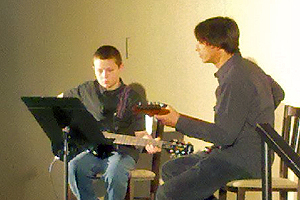Dean Cutinelli here from the Colorado School of Music. Remember we are just a call away to start your private music lessons. We offer guitar lessons, piano lessons, drum lessons, Violin lessons, vocal lessons as well orchestral instruments. Now on to our discussion about chords and the theory behind them.
Today I’ll be breaking down the difference between most of the chord types you may encounter regardless of what instrument you play. This will be part 1 of 2 in chords and the theory behind them. Chords are just based on basic math and a few different types of chord code. I’ll be taking this from the basics all the way through your different extensions.
The definition of a chord is a group of notes sounding together. Your most basic chord could have just 2 notes. For example the rock and metal world have made there sound with this type of chord. I’m referring to a power chord or more correctly called a root fifth chord. E5 , A5 , G5 etc… The root 5th chord is always a perfect fifth interval. It is not major or minor. Your next most basic chord is a chord consisting of a root 3rd and 5th. These chords can be major, minor, diminished or augmented. These chords are all root 3rd, 5th, with either the 3rd moving sharp or flat or the 5th moving sharp or flat. I think the best way to see these chords are with chord definitions. Below are the basic definitions.
R=Root C Major Scale = CDEFGAB
R-5th = C-G = C5 (Power Chord)
R-3rd-5th = C-E-G = C
R-b3rd-5th = C-Eb-G = Cmin
R-b3rd-b5th = C-Eb-Gb = CDim
Now I am going to go into some of the extensions and alterations for chords. A common chord you see is the sus Chord. Sus is an abbreviation for suspended which in music means remove the 3rd from the chord. Csus4 is a good example. This chord tells me to play a C chord but remove the 3rd and add the note that is 4 away from C. The note it’s asking us to add is F. Now our chord would have a R-5th+4th. (C-G-F) It’s usually preferred to put the extension in the higher register of the chord. (C-G-F) Another common sus chord is sus 2. (C-G-D) An add nine chord is a common chord. An example of this chord is Cadd9. The definition for this chord is R-3rd-5th+9. (C-E-G+D) The 9 is considered an extension to the chord. This Cadd9 chord is not the same as C9 chord.(C-E-G-Bb+D) I will get into discussing more chord types in my second addition to chords and the theory behind them.
Feel free to come in to the Colorado School of Music and take a lesson from me. We offer guitar lessons, piano lessons, drum lessons, violin lessons and vocal lessons as wells as orchestral instruments.
